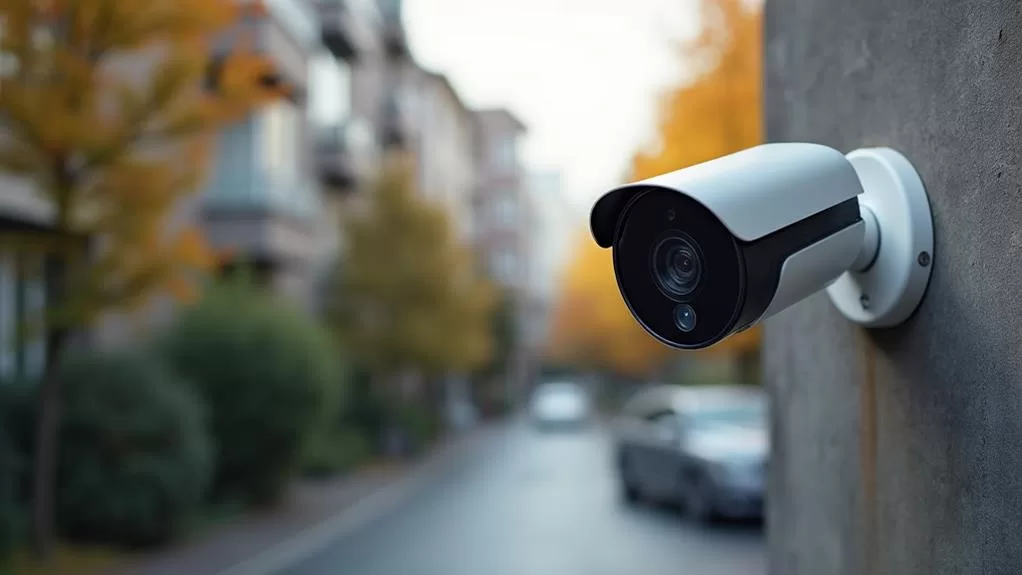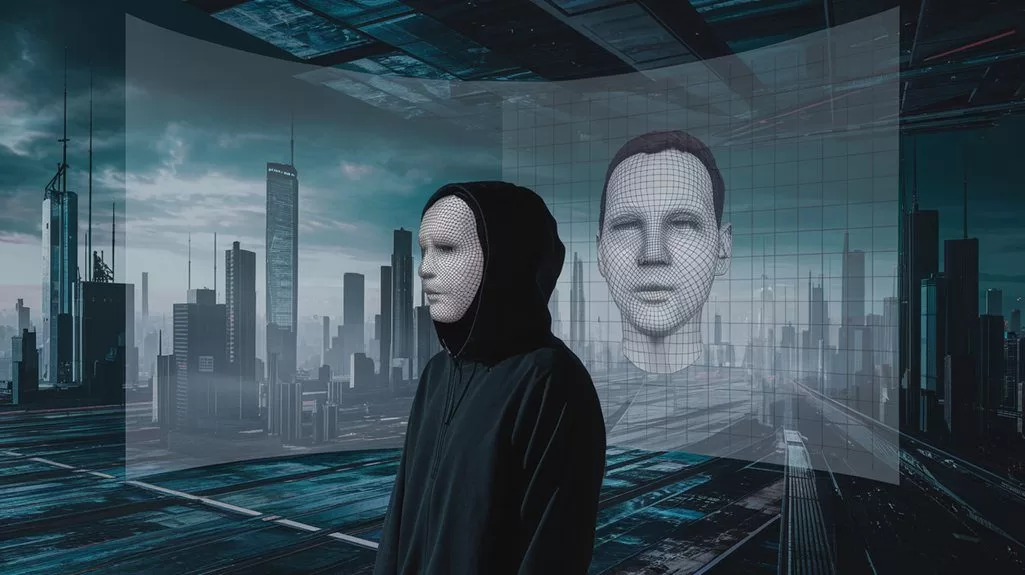AI-powered surveillance systems, like IC Realtime's Ella, have revolutionized security monitoring by enabling real-time video analysis and natural language search capabilities. These systems can instantly identify and track specific objects, people, and events within vast amounts of footage, enhancing public safety and security efficiency. Advanced video analytics powered by AI and machine learning detect anomalies, recognize objects, and flag irregularities without human intervention. This technology also integrates seamlessly with existing security systems, providing immediate alerts for suspicious activities and boosting overall surveillance effectiveness. As AI in surveillance continues to evolve, it's essential to balance security gains with ethical considerations and privacy concerns, and there's more to explore on how these advancements shape the future of security.
Key Takeaways
- Real-Time Analysis: AI surveillance systems like IC Realtime's Ella analyze live video feeds in real-time, enabling immediate detection and response to potential threats.
- Advanced Object Recognition: AI systems differentiate between humans, vehicles, and objects, reducing false alarms and enhancing security monitoring through precise object recognition.
- Behavioral Analytics: AI-driven systems detect anomalies by analyzing behavioral patterns, flagging irregularities such as unauthorized access without initial programming.
- Continuous Monitoring: AI-powered cameras continuously monitor video streams, providing instant threat detection and alerts without human intervention.
- Enhanced Security Capabilities: Integration with security systems allows AI to distinguish between normal and harmful behaviors, increasing the accuracy and efficiency of threat detection.
Evolution of AI Surveillance
The evolution of AI surveillance has transformed the security landscape, enabling cameras to analyze live video feeds without the constant need for human monitoring. With advancements in machine learning and deep learning, AI surveillance systems can now automatically analyze video footage in real-time, identifying and flagging events of interest. Platforms like IC Realtime's Ella have revolutionized the field by making video surveillance instantly searchable with natural language queries, allowing users to quickly locate specific objects, colors, or even car models within vast amounts of footage.
AI surveillance systems have become adept at recognizing objects, colors, and patterns, enhancing public safety across various industries such as retail, transportation, and healthcare. These systems can also learn from historical data, predicting potential security risks and taking preemptive measures.
While some advanced AI surveillance platforms, like those in certain regions, employ facial recognition technology for enhanced surveillance capabilities, the core functionality of AI in surveillance remains its ability to autonomously analyze and respond to video feeds. This automation has notably reduced the reliance on human operators, making security systems more efficient and proactive.
Advanced Video Analytics
Advanced video analytics, powered by AI and machine learning, greatly enhance security monitoring by recognizing specific objects, detecting anomalies in real-time, and analyzing behavioral patterns.
These systems can identify humans, vehicles, and other objects with high accuracy, even in complex scenarios, and alert operators to unusual activities without needing initial programming.
Object Recognition Capabilities
Object recognition, a cornerstone of AI-enhanced video surveillance, transforms how we monitor and secure environments. Advanced video analytics, powered by AI, can distinguish between humans, vehicles, and specific objects from general movements, greatly boosting the accuracy of security cameras.
Object Recognition Capabilities Table
| Capability | Description |
|---|---|
| Human Detection | AI recognition systems can identify and track individuals, even in crowded areas. |
| Vehicle Identification | These systems can classify vehicles and track their movements, aiding in traffic management and security. |
| Object Classification | AI algorithms can recognize and classify various objects, such as packages, animals, and other items of interest, reducing false alarms. |
AI in surveillance enables the recognition of patterns to identify objects of interest in real-time, which is essential for proactive security measures. Behavioral analytics, a form of self-learning AI, can detect anomalies based on observed patterns without initial programming, making it highly effective in identifying unusual behaviors. This broadens scanning capabilities beyond human capacity, vetting data for relevance and alerting human officers proactively. Moreover, AI in video surveillance aids in identifying unsafe acts by employees and can intercept and prevent incidents efficiently, ensuring a safer work environment.
Real-Time Anomaly Detection
Real-time anomaly detection, powered by AI-driven video analytics, revolutionizes how we secure environments by pinpointing unusual activities instantly. AI-powered systems are designed to continuously monitor video feeds, leveraging machine learning to recognize patterns and identify objects of interest. This capability is essential for distinguishing humans, vehicles, and specific objects from general movements, significantly reducing false alarms that plague traditional surveillance systems.
These systems can establish a baseline of normal behavior patterns within any given environment, enabling them to detect anything unusual. For instance, if someone enters a restricted area during off-hours or exhibits suspicious behavior, the AI will flag this irregularity and alert security personnel in real-time.
Behavioral analytics, a form of self-learning AI, enhance security by adapting to new data without initial programming, making them highly effective in proactive incident prevention.
Behavioral Pattern Analysis
Behavioral pattern analysis is an advanced aspect of AI-driven video analytics, allowing systems to recognize and learn from patterns of behavior. This advanced technology enables AI to detect anomalies by analyzing deviations from observed behavioral patterns, which is essential for identifying potential security threats. Unlike traditional systems, this form of AI doesn't require initial programming and is self-learning, making it highly effective in real-time anomaly detection.
In the context of security, behavioral analytics broadens scanning capabilities beyond human capacity, allowing for the proactive interception and prevention of security incidents. By continuously analyzing video feeds, AI-powered systems can identify unusual behavior that mightn't be apparent to human observers. This real-time analysis helps in promptly flagging and addressing security threats, thereby enhancing overall security measures.
The integration of AI in video surveillance not only automates the detection process but also guarantees that it operates autonomously, making decisions without human intervention. This autonomous decision-making capability is essential for swift responses to potential security breaches, thereby providing a robust layer of protection against various threats.
Real-Time Threat Detection

AI-powered secret security cameras leverage advanced algorithms to detect potential threats in real-time, enabling immediate alerts and responses to suspicious activities. These cameras can instantly identify objects of interest, such as intruders or unauthorized access, and trigger alerts to security personnel.
AI-Powered Object Detection
AI algorithms in secret security cameras are constantly at work, enhancing object detection to a level of precision that measurably boosts security measures. These cameras utilize artificial intelligence to identify and classify objects in live video feeds, allowing for real-time threat detection. This capability means that AI-powered security cameras can recognize suspicious activities or unauthorized objects, such as intruders, unattended packages, or specific merchandise, and alert authorities promptly.
The technology behind AI-powered object detection involves advanced algorithms that learn and adapt over time, improving their accuracy in identifying potential threats. By integrating computer vision and machine learning techniques, these cameras can distinguish between genuine security threats and false alarms, reducing the likelihood of unnecessary notifications. This precision enhances overall surveillance effectiveness, ensuring that security personnel can focus on actual risks rather than irrelevant events.
In practice, AI-powered object detection in secret security cameras translates into enhanced security measures. For instance, in retail environments, these cameras can track specific merchandise, detect anomalies in customer behavior, and alert staff to potential shoplifting incidents.
Similarly, in public spaces, they can identify and track vehicles, pedestrians, and other objects, aiding in the swift response to security breaches. This real-time threat detection notably improves the effectiveness of surveillance, making these cameras invaluable for maintaining security and safety.
Real-Time Anomaly Alerting
Real-time anomaly alerting is an essential feature of AI-powered secret security cameras, enabling immediate detection of unusual or threatening behavior. These cameras leverage advanced algorithms to analyze live video feeds and detect anomalies in real-time, distinguishing between normal activities and potential threats. Here's how it works:
- Continuous Monitoring: AI in secret security cameras continuously monitors video streams, providing instant threat detection without the need for human intervention.
- Advanced Algorithms: These algorithms can analyze large amounts of data quickly, identifying patterns and anomalies that might otherwise go unnoticed.
- Prompt Alerts: Once an anomaly is detected, the system triggers alerts for prompt action, enhancing the security capabilities of the cameras by quickly identifying suspicious behaviors.
Object and Face Recognition
When it comes to enhancing surveillance, secret security cameras equipped with advanced object and face recognition algorithms are a game-changer. These cameras leverage AI to identify specific objects, people, and behaviors in real-time, greatly improving the efficacy of surveillance systems.
Object recognition is a critical component of this technology. It enables cameras to detect and track specific items or movements within a surveillance area. For instance, AI-powered cameras can distinguish between a person, a vehicle, or an unattended bag, triggering instant alerts to security personnel when potential threats are detected.
Face recognition technology takes this a step further by matching faces against watchlists or databases for security purposes. This feature is particularly useful in high-security areas, such as entryways and high-traffic zones, where identifying individuals is paramount. Facial recognition can distinguish familiar faces from unknown ones, ensuring authorized access and heightened security.
The integration of these AI-driven features transforms traditional surveillance into proactive security management. By accurately identifying and tracking objects and faces, these cameras contribute to advanced security monitoring capabilities, making them an invaluable asset for maintaining safety and operational efficiency.
Integration With Security Systems

The effective integration of AI with security systems is what truly reveals the full potential of secret security cameras. As a security expert, I can attest that AI integration enhances the capabilities of these cameras to detect and analyze suspicious activities in real time. Here are three key ways this integration boosts security:
- Real-time Alerts and Notifications: AI-powered security systems can provide immediate alerts and notifications based on detected anomalies, allowing for prompt responses to potential threats.
- Behavioral Distinction: These systems can automatically distinguish between normal and potentially harmful behaviors, reducing false alarms and increasing the accuracy of threat detection.
- Optimal Surveillance: While AI-powered cameras don't automatically adjust their own settings, they enhance the efficiency and accuracy of capturing and analyzing security footage by continuously learning and improving through machine learning algorithms.
This integration guarantees that security personnel receive critical information quickly, enabling them to intervene before incidents escalate. By combining AI with existing security infrastructure, we create a proactive shield against security threats, making our environments safer and more secure.
Practical Applications and Benefits
As security needs evolve, the practical applications and benefits of hidden AI security cameras become increasingly evident. These discreet devices offer more than just covert surveillance; they provide advanced security features that enhance protection and efficiency.
Hidden AI security cameras can be disguised as everyday objects, ensuring they blend seamlessly into their surroundings. This covert nature allows for unbiased monitoring, capturing genuine behaviors without alerting individuals to their presence.
With AI integration, these cameras go beyond simple recording. They utilize advanced analytics such as object recognition and pattern recognition to identify and classify objects, people, and activities in real-time.
Real-time alerts are a significant benefit, as these cameras can notify you immediately about potential security breaches or unusual activities. This proactive approach enables swift responses to threats, whether in a home or business setting.
Additionally, remote access allows you to monitor video footage from anywhere, ensuring you stay informed and in control of your security.
The integration of AI in these cameras makes them valuable tools for covert security measures, providing detailed insights and enhancing overall security efficacy. By leveraging these advanced features, you can deter theft, optimize operations, and improve safety with a level of discretion that traditional security cameras can't match.
Ethical Concerns and Privacy

How do we balance the advanced security benefits of AI-powered hidden cameras with the ethical concerns surrounding privacy invasion? The integration of AI in secret security cameras has transformed the landscape of surveillance, but it also raises significant ethical concerns.
- Privacy Invasion: AI-powered cameras can monitor and analyze vast amounts of data without individuals' knowledge or consent, leading to an intrusion into personal privacy. This lack of transparency erodes trust and creates a sense of unease.
- Surveillance Without Consent: The use of hidden AI cameras can lead to breaches in personal data protection, as individuals are unaware they're being monitored. This raises questions about the ethics of gathering information without explicit consent.
- Protection of Personal Privacy: Establishing clear regulations and boundaries is essential to protect individuals from intrusive surveillance. This includes ensuring data is collected and stored securely, and implementing measures like anonymization to minimize identifiable personal information.
The ethical considerations here are paramount, as the balance between security benefits and individual privacy rights must be carefully managed. Transparency and accountability are key to ensuring that AI-powered surveillance systems don't overstep their bounds. By prioritizing ethical practices, we can mitigate the risks associated with AI in secret security cameras and safeguard personal privacy.
Challenges and Limitations
Despite the advanced security benefits of AI-powered hidden cameras, several challenges and limitations must be addressed to guarantee their efficient and ethical use. One significant issue is that machines struggle to comprehend the world like humans, which can impact the effectiveness of AI surveillance systems. For example, AI can identify actions in videos but often struggles with grasping the context in which they occur. This lack of contextual understanding can lead to false alarms and misinterpretation of events, potentially resulting in hazardous situations.
The resolution of video footage also plays a pivotal role in AI's ability to accurately analyze human actions. Low-resolution footage can severely limit the machine's ability to detect and interpret movements, further worsening the potential for misinterpretation.
Additionally, biases in AI systems, which can be embedded during training, can lead to discriminatory outcomes. For instance, AI-powered surveillance systems may mislabel or misinterpret actions based on pre-existing biases, compromising the trustworthiness of the system.
Addressing these challenges is vital to guarantee that camera surveillance systems, enhanced by machine vision, operate both efficiently and ethically. This involves rigorous testing, bias mitigation, and continuous improvement to minimize false alarms and ensure that AI systems provide accurate and contextually pertinent information.
Future Developments and Implications

Future developments in AI-powered covert security cameras promise to revolutionize surveillance with enhanced capabilities. As we investigate the future of these cameras, several key advancements stand out:
- Improved Facial Recognition: AI-powered facial recognition technology will become even more advanced, enabling the precise identification and tracking of individuals in real-time. This feature is particularly valuable for high-security environments, such as airports and government facilities, where public safety is paramount.
- Proactive Analysis: The integration of AI algorithms will allow these cameras to anticipate potential security threats before they occur. By analyzing patterns and anomalies in data, these systems can predict and prevent security breaches, enhancing overall security posture.
- Enhanced Image Processing: Advancements in image processing techniques will lead to clearer surveillance footage, even in challenging conditions. This enhancement will aid in more precise tracking and monitoring of targets.
However, these advancements also raise significant ethical considerations, particularly regarding privacy concerns. As AI technology becomes more widespread, ensuring responsible and ethical use is essential to maintaining public trust while enhancing public safety. The balance between security and privacy will be a key challenge moving forward.
Frequently Asked Questions
What Is AI Detection on Security Cameras?
AI detection on security cameras uses algorithms to recognize and analyze objects, people, and behaviors, but it raises privacy concerns, can produce false positives, and has significant ethical implications, requiring careful consideration and oversight.
Can a Cell Phone Detect a Hidden Camera?
Yes, a cell phone can help with hidden camera detection. Use your phone's camera to scan for infrared lights in dark rooms, which many hidden cameras emit. Cell phone apps can also aid, though they may not be foolproof, addressing privacy concerns.
How to Use AI in Surveillance?
To use AI in surveillance, I leverage facial recognition to identify individuals, motion tracking to monitor object movements, and behavior analysis to detect anomalies, enabling proactive security measures and instant alerts for potential threats.
What Is the AI System for Cameras?
The AI system for cameras uses machine learning to analyze video footage, enabling facial recognition, object tracking, and behavior analysis. It detects anomalies in real-time, triggering alerts for specific events, and enhances surveillance capabilities greatly.
Final Thoughts
To sum up, AI surveillance has transformed security by automating threat detection, enhancing object and face recognition, and integrating seamlessly with other security systems. While these advancements offer significant benefits, they also raise ethical concerns and privacy issues. As AI continues to evolve, addressing challenges like bias and cybersecurity will be essential. The future of surveillance lies in balancing innovation with responsibility, ensuring that AI enhances security without compromising individual freedoms.









